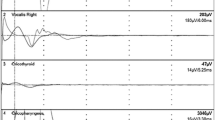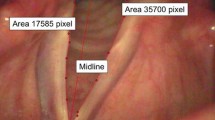Abstract
Objectives
We investigated the effect of different levels of continuous positive airway pressure (CPAP) on the cricothyroid (CT; a tensor muscle of the vocal folds) and posterior cricoarytenoid (PCA; sole abductor muscle of the vocal folds) muscles in dogs.
Design
Prospective, controlled animal study.
Subjects
Nine mongrel dogs of both sexes.
Setting
University research laboratory.
Interventions
After insertion of a cuffed tracheotomy tube low in the neck the compound EMG responses of the CT and PCA muscles during spontaneous respiration were measured simultaneously under different levels (2, 4, 6, and 8 cmH2O) of positive end-expiratory pressure (PEEP).
Measurements and results
The CT showed a progressive increase in phasic expiratory EMG activity with the application of graded levels of PEEP. Application of PEEP over 4 cmH2O produced significant increases in the phasic CT activity (P<0.05). In contrast to the CT, the PCA failed to increase phasic inspiratory EMG activity statistically until a 8 cmH2O of PEEP was applied (P<0.05). The phasic experatory CT and inspiratory PCA activities were 297.9±77.6 and 124.5±22.9, respectively, at the application of 6 cmH2O of PEEP (percentage of control, mean±SD).
Conclusion
This study confirms the difference in sensitivity between adductor and abductor laryngeal muscles, demonstrating that the intrinsic laryngeal muscles do not all behave similarly after the application of CPAP.
Similar content being viewed by others
References
Martin RJ, Lunteren EV, Haxhiu MA, Carlo WA (1990) Upper airway muscle and diaphragm responses to hypoxia in the piglet. J Appl Physiol 68:672
Road JD, Leevers AM (1990) Inspiratory and expiratory muscle function during continuous positive airway pressure in dogs. J Appl Physiol 68:1092
Series F, Cormier Y, Couture J, Desmeules M (1990) Changes in upper airway resistance with lung inflation and positive airway pressure. J Appl Physiol 68:1075
England SJ, Bartlett D (1982) Changes in respiratory movements of the human vocal cords during hypercapnia. J Appl Physiol 52:780
Eyzaguirre C, Taylor JR (1963) Respiratory discharges of some vagal motoneurons. J Neurophysiol 26:61
Dixon M, Szereda-Przestaszewska M, Widdicombe JG, Wise JCM (1974) Studies on laryngeal calibre during stimulation of peripheral and central chemoreceptors, pneumothorax and increased respiratory loads. J Physiol (London) 239:347
Harding R (1980) State-related and developmental changes in laryngeal function. Sleep 3:307
Stansky A, Szereda-Przestaszewska M, Widdicombe JG (1973) The effects of lung reflexes on laryngeal resistance and motoneuron discharge. J Physiol (London) 231:417
Glogowska M, Strnsky A, Widdicombe JG (1974) Reflex control of discharge in motor fibres to the larynx. J Physiol (London) 239:365
Remmers JE (1973) Extra-segmental reflexes derived from intercostal afferents: phrenic and laryngeal responses. J Appl Physiol 233:45
Price WM, Bastsel HL (1970) Respiratory neurons participating in sneeze and in response to resistance to expiration. Exp Neurol 29:554
Richardson CA, Mitchell RA (1982) Power spectral analysis of inspiratory nerve activity in the decerebrate cat. Brain Res 233:317
Sherry JH, Megirigan D (1975) Analysis of the respiratory role of intrinsic laryngeal motoneurons. Exp Neurol 49:456
Nakamura F, Ueda Y, Sonoda Y (1958) Electromyographic study of respiratory movements of the intrinsic laryngeal muscles. Laryngoscope 68:109
Mathew OP, Woodson GE, Saint' Ambrogio F, Saint' Ambrogio G (1988) Respiratory activity of the cricothyroid muscle. Ann Otol Rhinol Laryngol 97:680
Sherrey JH, Megirian D (1974) Spontaneous and reflexly evoked laryngeal abductor and adductor muscle activity of cat. Exp Neurol 43:487–498
Brancatisano A, Dodd DS, Engel LA (1991) Posterior cricoarytenoid activity and glottic size during hyperpnea in humans. J Appl Physiol 71:977
Brancatisano A, Dodd DS, Engel LA (1991) Posterior cricoarytenoid activity and glottic size during hyperpnea in humans. J Appl Physiol 71:977
Author information
Authors and Affiliations
Rights and permissions
About this article
Cite this article
Iwasaki, H., Ohmori, H., Sumita, S. et al. Influence of continuous positive airway pressure on EMG activities of the cricothyroid and posterior cricoarytenoid muscles of the canine larynx. Intensive Care Med 22, 805–808 (1996). https://doi.org/10.1007/BF01709524
Received:
Accepted:
Issue Date:
DOI: https://doi.org/10.1007/BF01709524




